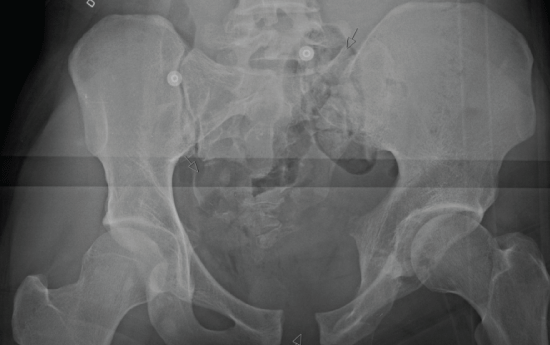Haemorrhage Control Following Massive Pelvic Bleeding
Objectives
• Massive pelvic bleeding has a high mortality rate [1]. Several measures like pelvic vessel ligations, mechanical stabilization of disrupted pelvic ring, pelvic packing, and pelvic angiography and ongoing embolization [2-6].
• However the problem seems to be still unsolved [1].
• Here we represent a case report with massive intra pelvic vascular injuries.
Case Report
Young man, 25-years-old jumped from a bridge roughly 15 meters. Policemen arrive after 2 minutes and found this young man unconscious without vital signs and starts cardiopulmonary resuscitation immediately. When ambulance arrives after 3 minutes they found a young man with palpable carotids pulses and shallow breathing. Head exam showed no sign of injury. Bilateral fractures of lower arms were visible. Left lower extremity was fractured and dislocated. Abdomen has been palpated soft and non-tender. No blood was found on the floor. GCS (Glasgow Coma Scale Score) of 3 was continuously reported during transport to the hospitals. Pulse rate was 100 with no measurable blood pressure.The patient has been intubated with on going Oxygen therapy and stabilized with neck collar on a spine board after gross reposition of fractures in pre-hospital setting.
Transport time was 16 minutes to the hospital. Upon admission directly to the trauma bay a chest X-ray, pelvic X-ray and FAST (Focused Assessment Sonography in Trauma) was done. A left sided APC II (Antero-posterior Type II fracture according to Young-Burgess) injury was reported on pelvic X-ray (Figure 1) and the patient receives pelvic binder.
Chest X-ray shows a bilateral pneumothorax and patient received chest drains with bubbles and no sign of hemothorax. FAST shows on going bleeding in "Douglas Pouch".
Blood- and blood gas analysis showed Hemoglobin 140 mmol/L, INR (International Normalized Ratio for blood clotting time) 1.1 (Ref. < 1.2), APTT (Activated Partial Thromboplastin Time) 70 (28-40), Plasma fibrinogen 1.5 (2.0-4.2), Thrombocytes count 234 (Ref. 145-348), pH 6.9.
Hemodynamic status of the patient was evaluated in "Extremis" and decision was made to perform urgent laparotomy. An initial incision was made below the umbilicus. Observation showed dissecting hematoma retroperitonellay, which was packed. Further laparotomy showed normal liver and spleen. Retro-omental hematoma was observed no major visceral injuries were found.
Compression over the abdominal aorta raised the blood pressure and REBOA (Resuscitative Endovascular Balloon Occlusion of the Aorta) was applied to the level of Th.10 maintained the blood pressure to 70 mmHg.
Release of REBOA during course of angiography contributed to drop of blood pressure and uncontrolled bleeding again.
Massive transfusion according to protocol (21 PRBC (Packed Red Blood Cells) and FFP (Fresh Frozen Plasma) and Thrombocytes) was transfused during course of trauma care. Decision was finally made to stop the resuscitative surgery and the patient was declared dead. Total duration of resuscitation was estimated 2.5 hours (23:30-02:09).
Cause of death was related to renal artery lacerations, several pelvic arterial injuries.
Discussion
Historically have several attempts were introduced to solve the problem with high mortality from massive pelvic bleeding [2-7]. Endovascular Application of an Aortic Balloon (REBOA) was initially introduced in 1954 [8]. A systematic review of the literature did not show promising results of REBOA in traumatic zone 3 abdominal bleedings [7].
The question still exists how to handle these fatal injuries to gain hemodynamic stability.
Ligation of major pelvic arteries with following amputation of pelvis or femurs have been reported successful in few cases [1].
The ethical aspect of this issue is disturbing for the surgeon in charge obviously during the off hours with no experienced colleagues around.
The question is how many surgeons would feel comfortable to ligate major vessels in Zone 3 pelvic and abdominal vascular injuries.
In our case some how hemodynamic stability has been achieved following aorta compression below the level of renal arteries and following insertion of REBOA in the level of Th. 10, which is above the level of renal arteries. Keeping a constant arterial pressure in this area, contributes to visceral and extremity injuries.
Conclusion
Pelvic injury with massive vascular injuries not responding to arterial embolization and pelvic packing are fatal injuries. Saving the patient's life by mean of ligation of major arteries below the level of renal arteries has considerable ethical issues.
References
- Rothenberger DA, Fischer RP, Perry JF Jr (1978) Major vascular injuries secondary to pelvic fractures: an unsolved clinical problem. American Journal of Surgery 136: 660-662.
- DuBose J, Inaba K, Barmparas G, et al. (2010) Bilateral internal iliac artery ligation as a damage control approach in massive retroperitoneal bleeding after pelvic fracture. J Trauma 69: 1507-1514.
- Mears DC, Rubash HE (1984) External and internal fixation of the pelvic ring. Instr Course Lect 33: 144-158.
- Papakostidis C, Kanakaris N, Dimitriou R, et al. (2012) The role of arterial embolization in controlling pelvic fracture haemorrhage: a systematic review of the literature. Eur J Radiol 81: 897-904.
- Tötterman A, Madsen JE, Skaga NO, et al. (2007) Extraperitoneal pelvic packing: a salvage procedure to control massive traumatic pelvic hemorrhage. J Trauma 62: 843-852.
- Vermeulen B, Peter R, Hoffmeyer P, et al. (1999) Prehospital stabilization of pelvic dislocations: A new strap belt to provide temporary hemodynamic stabilization. Swiss Surg 5: 43-46.
- Morrison JJ, Galgon RE, Jansen JO, et al. (2016) A systematic review of the use of resuscitative endovascular balloon occlusion of the aorta in the management of hemorrhagic shock. J Trauma Acute Care Surg 80: 324-334.
- Hughes CW (1954) Use of an intra-aortic balloon catheter tamponade for controlling intra-abdominal hemorrhage in man. Surgery 36: 65-68.
Corresponding Author
Peyman Bakhshayesh, Department of Molecular Medicine and Surgery, Karolinska Institute Stockholm, Sweden, Tel: 0046-723613313.
Copyright
© 2017 Bakhshayesh P. This is an open-access article distributed under the terms of the Creative Commons Attribution License, which permits unrestricted use, distribution, and reproduction in any medium, provided the original author and source are credited.





